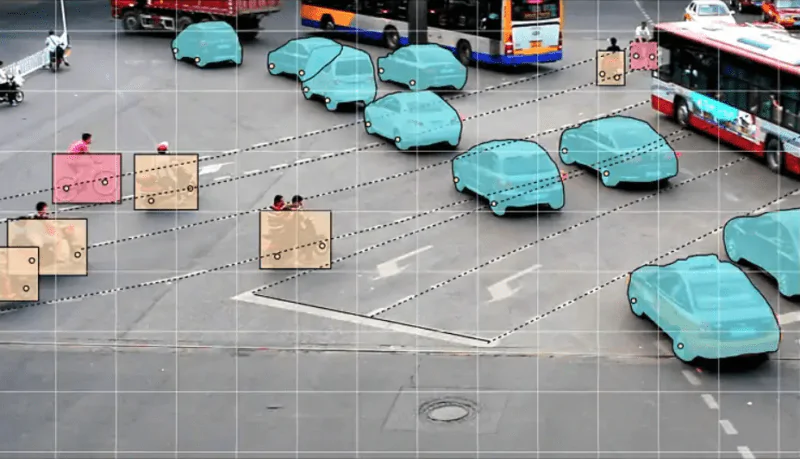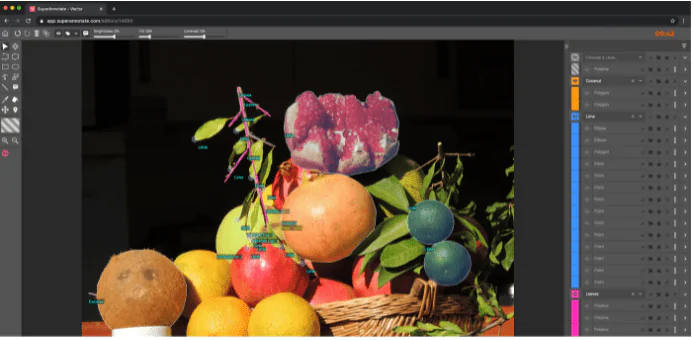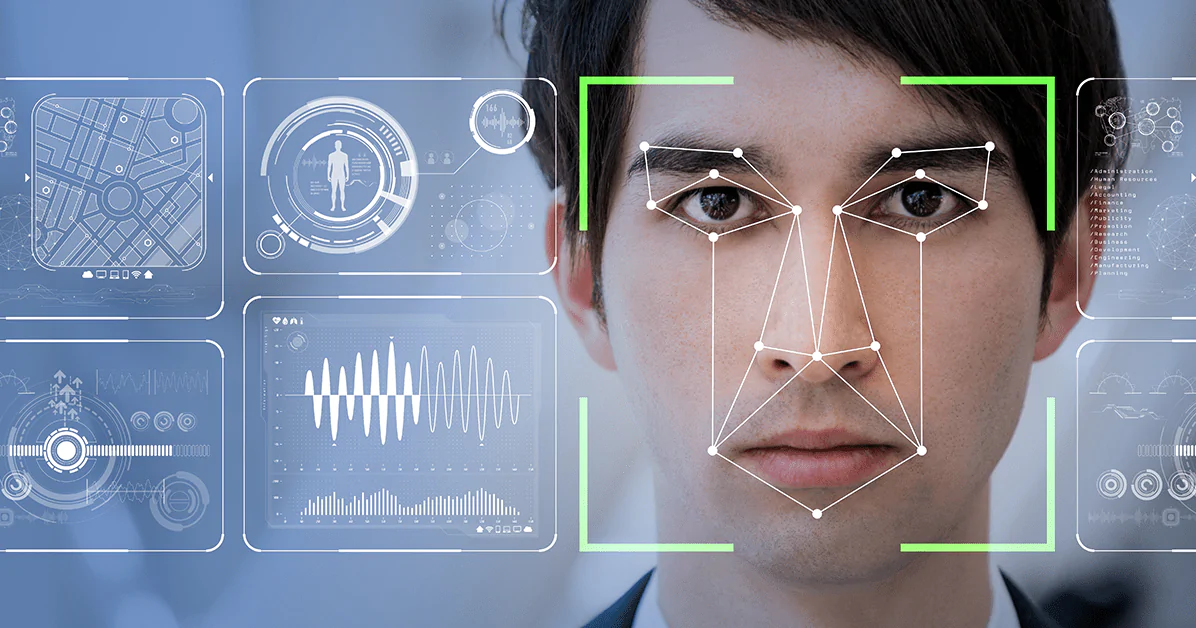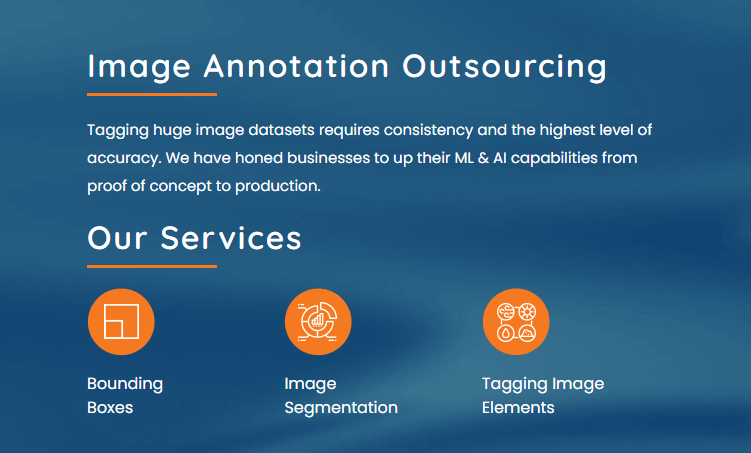A Comprehensive Guide to Image Annotation in 2024

Need help with image annotation or image annotation services? Look no further! This comprehensive guide provides a detailed overview of the process and offers handy tips to get you started. Image annotation is the process of tagging and categorising an image based on its visual elements. It involves using semantic markers to identify objects, people, locations, or activities within an image. This guide provides an overview of what image annotation is and offers helpful tips to get you started.
What is Image Annotation?
Image annotation is the process of adding metadata, labels, or tags to an image dataset to provide additional information about its content. This metadata can include information such as object detection, image segmentation, bounding boxes, and semantic segmentation.
Image annotation is required for a variety of computer vision tasks, such as training machine learning models to recognise objects, faces, and scenes in images. Developers can train algorithms to recognise and classify images with greater accuracy by labelling and annotating images, allowing for more advanced computer vision applications.
Some common types of image annotation include:
- Bounding box annotation: drawing a rectangular box around objects in an image to identify their location and size.
- Semantic segmentation annotation: labeling each pixel in an image with a corresponding object category.
- Object detection annotation: labeling specific objects in an image and drawing a bounding box around them.
- Image classification annotation: assigning a category or label to an entire image based on its content.

How Does an Image Annotation Work
- Select an annotation tool: There are several annotation tools available, ranging from free to paid versions. Some popular tools include Labelbox, VGG Image Annotator (VIA), and RectLabel.
- Choose the type of annotation: Depending on the use case, the type of annotation may vary. For example, if the task is to recognize objects in images, bounding box annotation may be used, whereas if the task is semantic segmentation, pixel-level annotation may be used.
- Upload the images to be annotated: The images to be annotated are uploaded to the annotation tool, and the annotations are added to the images.
- Add annotations: The annotator will then identify objects, regions, or areas of interest in the image and add appropriate annotations. For example, in object detection annotation, the annotator will draw a bounding box around the object of interest and label it with the appropriate class.
- Review and refine: Once the annotations are added, the images are reviewed to ensure that they are accurate and correctly labeled. If any mistakes are identified, the annotator can refine the annotations.
- Export the annotated dataset: Once the images are fully annotated, the dataset can be exported in a format that can be used to train machine learning models, such as COCO, PASCAL VOC, or YOLO.
Image annotation is a critical step in creating accurate and effective computer vision models, and the process can be time-consuming and require a significant amount of expertise. However, with the help of annotation tools and trained annotators, it is possible to create high-quality annotated datasets that can be used to train machine learning models.

What are Image Annotation Tools
Image annotation tools are software applications designed to simplify and streamline the process of annotating images. They offer a range of features to enable users to add metadata, labels, or tags to images, including object detection, image segmentation, and bounding box annotations. Here are some popular image annotation tools:
Labelbox: A cloud-based annotation platform that supports a wide range of annotation types, including bounding boxes, polygons, and keypoints. It offers advanced features such as image labeling automation, quality assurance workflows, and collaboration tools.
VGG Image Annotator (VIA): An open-source image annotation tool that supports multiple annotation types, including bounding boxes, polygons, and points. VIA is easy to use and provides a simple interface for annotating images.
RectLabel: A macOS-based annotation tool that supports bounding boxes, segmentation, and classifications. It offers features such as object tracking and advanced labeling tools.
Supervisely: A cloud-based platform that provides a comprehensive set of tools for annotating images, including object detection, instance segmentation, and classification. It also offers features such as automatic labeling, data augmentation, and model training.
Amazon SageMaker Ground Truth: A fully-managed annotation platform that allows users to annotate images using their own workforce or with the help of Amazon Mechanical Turk. It supports a wide range of annotation types and offers features such as human-in-the-loop model training and quality control workflows.
Features and Capabilities of image annotation platforms:
Annotation types: Image annotation platforms support a range of annotation types, such as bounding boxes, polygons, keypoints, and semantic segmentation. This allows users to choose the most appropriate annotation type for their use case.
Image management: Image annotation platforms provide tools for organizing and managing image datasets, such as uploading and downloading images, creating image sets, and sorting images by category or label.
Collaboration: Many annotation platforms allow multiple users to work on the same dataset simultaneously, and provide features for managing user permissions, tracking changes, and communicating with team members.
Quality control: Annotation platforms may provide features for ensuring the quality of annotations, such as automated quality checks, validation workflows, and user feedback tools.
Integration with machine learning frameworks: Some annotation platforms offer integration with machine learning frameworks, such as TensorFlow, PyTorch, or Keras, to streamline the process of training models on annotated datasets.
Data augmentation: Some annotation platforms offer data augmentation capabilities, such as image rotation, flipping, or cropping, to increase the size and diversity of the annotated dataset.
Automation: Some annotation platforms offer automated annotation capabilities, such as object detection, to reduce the amount of manual annotation required.
Types of Image Annotation in Detail
There are several types of image annotation used in computer vision tasks, depending on the specific use case and the type of information that needs to be extracted from the images. Here are some of the most common types of image annotation:
Bounding Box Annotation: This type of annotation involves drawing a rectangular box around an object of interest in an image. Bounding box annotation is commonly used for object detection tasks, where the goal is to identify the presence and location of specific objects in an image.
Polygon Annotation: Polygon annotation involves drawing a series of connected points around an object of interest to create a closed shape. Polygon annotation is commonly used for more complex shapes that cannot be easily captured with a bounding box, such as objects with irregular shapes.
Semantic Segmentation Annotation: Semantic segmentation involves dividing an image into regions or segments, each of which is labeled with a specific class. This type of annotation is commonly used for tasks such as image segmentation or object recognition, where the goal is to identify the boundaries of objects within an image.
Instance Segmentation Annotation: Instance segmentation is similar to semantic segmentation, but it also involves identifying individual instances of objects within an image. This type of annotation is commonly used for tasks such as tracking objects over time, or counting the number of instances of a specific object in an image.
Keypoint Annotation: Keypoint annotation involves identifying specific points of interest within an image, such as the corners of a building or the joints of a person’s body. This type of annotation is commonly used for tasks such as pose estimation or object tracking.

Image Classification:
Image classification is a computer vision task that involves categorizing images into different classes or categories. The goal of image classification is to teach a machine learning model to recognize the visual features that distinguish one class from another and make accurate predictions about new images it has not seen before.
To perform image classification, a machine learning model is trained on a dataset of labeled images, where each image is assigned a specific class label. The model learns to extract features from the images, such as color, texture, and shape, and uses these features to make predictions about the class of new images.
There are several steps involved in performing image classification:
Data collection and preparation: A large and diverse dataset of labeled images is collected, cleaned, and preprocessed to ensure that the images are of high quality and the labels are accurate.
Model selection: A suitable machine learning model is selected based on the specific requirements of the task, such as accuracy, speed, and resource requirements.
Training the model: The selected model is trained on the labeled image dataset using an algorithm such as backpropagation. During training, the model learns to adjust its internal parameters to minimize the error between its predicted class labels and the actual class labels.
Model evaluation: The trained model is evaluated on a separate set of test images to measure its performance, such as accuracy, precision, and recall.
Deployment: Once the model is trained and evaluated, it can be deployed in real-world applications to classify new images and make predictions about their class labels.
Applications of Image Annotation:
Image annotation has numerous applications across a variety of fields, including computer vision, machine learning, and data science. Here are some of the most common applications of image annotation:
Object recognition: Image annotation is used to label objects within images, enabling machine learning models to recognize and classify objects in new images.
Autonomous driving: Image annotation is used to label images captured by cameras and sensors on autonomous vehicles, enabling the vehicles to recognize and respond to objects and obstacles in their environment.
Medical diagnosis: Image annotation is used to label medical images, such as X-rays or MRI scans, to assist in the diagnosis of diseases and conditions.
E-commerce: Image annotation is used to classify images of products, enabling online retailers to organize and categorize their product catalogs for more efficient search and recommendation systems.
Agriculture: Image annotation is used to label crop images to monitor crop health, identify pests or diseases, and improve crop yield and quality.
Surveillance: Image annotation is used to label images captured by security cameras, enabling the detection of suspicious behavior or activity.
Natural language processing: Image annotation is used to label images for use in natural language processing tasks, such as image captioning or sentiment analysis.
Importance of Image Annotation:
Training machine learning models: Image annotation is crucial for training machine learning models to recognize and classify objects in images. By labeling images with relevant metadata, such as object locations, shapes, and sizes, machine learning models can learn to identify and differentiate between different objects in an image.
Improving accuracy: Accurately annotated images can improve the accuracy of machine learning models by providing more detailed and precise information about the objects within an image. This can lead to more accurate predictions and better overall performance of the model.
Enabling automation: Image annotation is a critical step in enabling automation of tasks that rely on visual information. By automating the process of annotating images, tasks such as object recognition, medical diagnosis, and autonomous driving can be performed more efficiently and effectively.
Enabling new applications: Image annotation enables new applications and use cases that rely on computer vision, such as surveillance, agriculture, and e-commerce. By providing machines with a better understanding of the visual world, new and innovative applications can be developed that improve efficiency, safety, and productivity.
Image Annotation Service:
However, in general, image annotation services offered by our company (24x7offshoring) typically involve the manual labeling of images by trained professionals. Our professionals use specialized tools and techniques to annotate images with relevant metadata, such as object locations, shapes, and sizes, and ensure that the annotations are accurate and consistent.
Some common types of image annotation services offered by 24x7offshoring include:
Object detection: This involves labeling objects within images with bounding boxes, enabling machine learning models to recognize and locate objects in new images.
Image classification: This involves labeling images with relevant class labels, enabling machine learning models to categorize new images based on their content.
Semantic segmentation: This involves labeling each pixel within an image with a specific class label, enabling more detailed and precise analysis of the image.
Landmark annotation: This involves labeling specific points or landmarks within an image, enabling more detailed analysis of the shape and structure of objects within the image.

Frequently Asked Questions(FAQs)
1. How image annotate?
The practise of labelling an image or set of images is known as image annotation. A human operator examines a collection of images, identifies relevant objects in each image, and annotates the image, for example, by indicating the shape and label of each object.
2. What is image annotation tool?
An image annotation tool is a software program or application that is designed to help users add annotations, labels, or metadata to images. These tools are commonly used in computer vision and machine learning applications to train and test algorithms that rely on image recognition.
3. What are 5 annotation techniques?
- Bounding Box Annotation
- Semantic Segmentation
- Instance Segmentation
- Key-point Annotation
- Line Annotation
